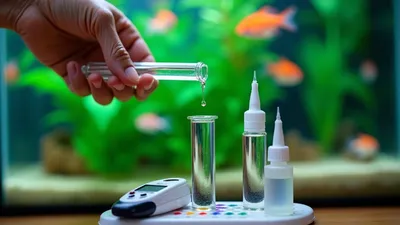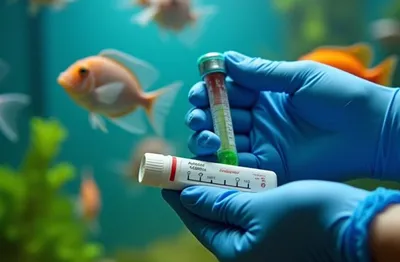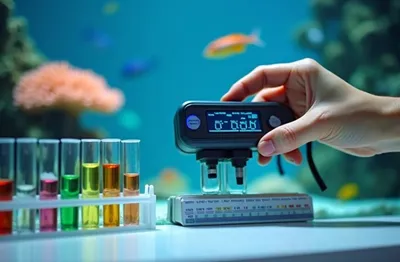To test your aquarium’s water hardness, you’ll need a liquid reagent kit or test strips. Rinse the test tube with tank water, fill to the line, add the specified drops, and gently invert to mix. Compare the resulting color against the chart in natural light. Different tropical species require specific hardness levels—tetras prefer soft water while cichlids thrive in harder conditions. Regular testing guarantees your fish stay healthy and comfortable in their underwater home.
Contents
- 1 Understanding Water Hardness for Tropical Fish
- 2 Essential Equipment for Testing Water Hardness
- 3 Step-by-Step Water Hardness Testing Method
- 4 Interpreting Your Water Hardness Test Results
- 5 Ideal Hardness Ranges for Popular Tropical Fish Species
- 6 Adjusting Water Hardness in Your Aquarium
- 7 Common Water Hardness Problems and Solutions
- 8 Establishing a Water Hardness Testing Schedule
- 9 Frequently Asked Questions
- 10 Final Thoughts
Understanding Water Hardness for Tropical Fish
When you’re diving into the world of tropical fish keeping, understanding water hardness becomes one of your most essential skills.
Water hardness refers to the concentration of minerals, particularly calcium and magnesium, dissolved in your aquarium water. These minerals greatly impact your tank’s water chemistry and, consequently, your fish health.
Different tropical fish species have evolved in specific water conditions in their natural habitats. Some thrive in soft water (low mineral content), while others need hard water (high mineral content) to flourish.
If you keep fish in water with inappropriate hardness levels, they might struggle to regulate their internal salt balance, affecting their breathing, metabolism, and reproduction.
Think of water hardness as part of your fish’s home environment—just as you’d feel uncomfortable in extreme weather conditions, your fish need their water “comfort zone” too!
Essential Equipment for Testing Water Hardness
You’ll need a few essential tools to accurately measure water hardness for your tropical fish.
Test kits and strips offer a quick way to check hardness levels, while digital hardness meters provide more precise readings for serious aquarists.
Don’t forget to keep reference solutions on hand to calibrate your equipment and guarantee you’re getting accurate results that’ll keep your finned friends healthy and thriving.
Test Kits and Strips
Accurate testing of water hardness begins with having the right tools at your disposal.
You’ll find two main test kit types on the market: liquid reagent kits and test strips. Liquid reagent kits generally provide more precise readings but require you to carefully count drops and match colors. They’re worth the extra effort when you’re keeping sensitive tropical species that need specific water parameters.
Test strips offer convenience—simply dip, wait, and compare—but their strip accuracy can sometimes be questionable. If you’re using strips, store them properly in a cool, dry place with the container tightly sealed.
For the most reliable results, consider using both methods occasionally to cross-check your readings. Regular water quality checks ensure that your fish thrive in a well-balanced environment, so remember, your fish can’t tell you when the water hardness is off, so your testing tools become their voice!
Digital Hardness Meters
Digital hardness meters represent the high-tech alternative in the aquarium hobbyist’s toolkit, though they’re not essential for most tropical fish keepers.
If you’re managing multiple tanks or breeding sensitive species, you might find these handy devices worth the investment.
These meters provide instant readings without the color-matching guesswork of test strips. You’ll simply dip the probe into your aquarium, and voilà—a precise hardness reading appears on the digital display!
Remember that proper hardness calibration is vital for accuracy; most units come with calibration solutions you should use monthly.
The convenience comes at a price—digital meters typically cost more than test kits.
For beginners, this might seem like overkill, but experienced hobbyists often appreciate the speed and precision when monitoring water parameters becomes second nature.
Reference Solutions
Reference solutions stand as the unsung heroes of accurate water hardness testing, serving as your quality control checkpoints in tropical fish keeping.
These calibrated liquids guarantee your test kits are providing trustworthy results, which is vital when your finned friends’ health hangs in the balance!
You’ll find two primary reference solutions types: calibration standards and verification solutions.
Calibration standards help reset digital meters, while verification solutions confirm your test kits are working properly.
Don’t worry—you’re not limited to specialty aquarium shops for these lifesavers!
Reliable reference solutions sources include scientific supply companies, aquarium specialty retailers, and even DIY options (though these require careful preparation).
Think of these solutions as your aquarium’s reality check—they’ll save you from the heartbreak of incorrect water parameters and keep your underwater community thriving.
Additionally, maintaining ideal water quality parameters is essential for the overall health of your tropical fish.
Step-by-Step Water Hardness Testing Method
You’ll find several test kit options at your local pet store, including digital meters, test strips, and liquid reagent kits.
To get accurate readings, you’ll need to follow the manufacturer’s instructions carefully, making sure to collect a fresh water sample from your aquarium.
Once you’ve completed the test, you can accurately read the results by comparing the color change to the provided chart or by checking the digital display, depending on your chosen testing method.
Test Kit Options
When choosing the right tools to measure water hardness, several reliable test kit options are available for tropical fish keepers.
You’ll find both digital meters and liquid test kits at your local pet store, each with unique advantages.
For beginners, simple strip tests provide quick readings, though they’re less precise than advanced testing methods.
Digital meters offer convenience and accuracy but come with a higher price tag.
In our test kit comparisons, liquid reagent kits consistently deliver the most reliable results for the money.
These kits use color-changing chemicals that react with minerals in your water. Regular testing helps identify contaminants and optimal pH levels, which are crucial for aquatic life.
Proper Testing Technique
Testing your aquarium’s water hardness correctly requires following five essential steps to guarantee accurate readings.
First, rinse your test tube with aquarium water, then fill it to the marked line. Add the testing solution drops (usually 5-6), then cap and gently invert several times—don’t shake vigorously! Wait the specified time (typically 5 minutes) before comparing your result to the color chart.
- Consider environmental factors like room lighting when reading results—natural daylight gives the most accurate color matching.
- Maintain a regular testing frequency—weekly checks help track patterns and prevent sudden hardness shifts.
- Always wash your hands before testing to avoid contaminating samples.
- Store your test kit in a cool, dark place—heat and light can degrade the chemicals.
Reading Results Accurately
Now that you’ve mastered the proper technique, let’s focus on how to read your test results with confidence. Understanding your results isn’t just about numbers—it’s about interpreting what they mean for your finned friends.
First, check that your testing kit’s calibration techniques are current. Most kits include a color chart that shows various hardness levels. Hold the test tube against a white background in natural light for the most accurate reading. Don’t rush this step!
Accuracy factors include temperature and testing time. Make sure you’re reading results at the exact time specified—waiting too long can skew your results.
If you’re between two color shades, it’s better to assume the higher reading and adjust accordingly.
Interpreting Your Water Hardness Test Results
Once you’ve completed your water hardness test, you’ll need to understand what those numbers actually mean for your tropical fish.
Water hardness effects vary considerably depending on your fish species, with some thriving in soft water while others prefer harder conditions. You’re fundamentally providing an environment that supports ideal fish health when you match your water parameters to your fish’s natural habitat.
- Very soft water (0-50 ppm): Ideal for discus, cardinal tetras, and many South American species
- Moderately soft water (50-100 ppm): Perfect for most tetras, rasboras, and dwarf cichlids
- Moderately hard water (100-200 ppm): Suits livebearers like guppies and mollies
- Hard water (200+ ppm): Best for African cichlids and certain goldfish varieties
Don’t panic if your water doesn’t match your fish’s needs perfectly—gradual adaptation is possible! It’s also essential to consider the compatible species that can coexist harmoniously in your tank while you make adjustments.
Ideal Hardness Ranges for Popular Tropical Fish Species
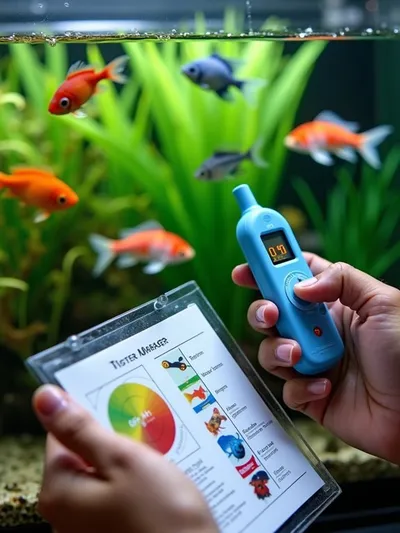
Different tropical fish species have evolved in specific water conditions, which explains why they’ve developed unique preferences for water hardness. Understanding these preferences is essential for their health and vibrant colors.
African cichlids thrive in hard water (10-25 °dH), while discus and angelfish prefer softer conditions (1-5 °dH).
Your tetras and rasboras will flourish in soft to medium hardness (2-10 °dH), but livebearers like guppies and mollies need harder water (12-20 °dH) to support their biological processes.
When creating your aquarium community, try grouping fish by similar hardness preferences. It’s like throwing a dinner party—you wouldn’t serve spicy food to guests who can’t handle heat!
Match ideal fish species to your water parameters, or adjust your water to meet their needs.
Adjusting Water Hardness in Your Aquarium
After testing your water and discovering it doesn’t match your fish’s preferences, you’ll need to know how to make adjustments. Changing water hardness isn’t complicated once you understand the basics.
For increasing hardness, add crushed coral or limestone to your filter media. To decrease hardness, try using reverse osmosis water or peat moss in your filtration system.
- Gradual changes are essential – adjust water hardness slowly over weeks to avoid stressing your fish.
- Regular testing helps monitor your aquarium adjustments and prevents unexpected fluctuations.
- Some fish adapt to different hardness levels, but breeding often requires specific conditions.
- Natural decorations like driftwood can gradually soften water, while coral decorations increase hardness.
Common Water Hardness Problems and Solutions
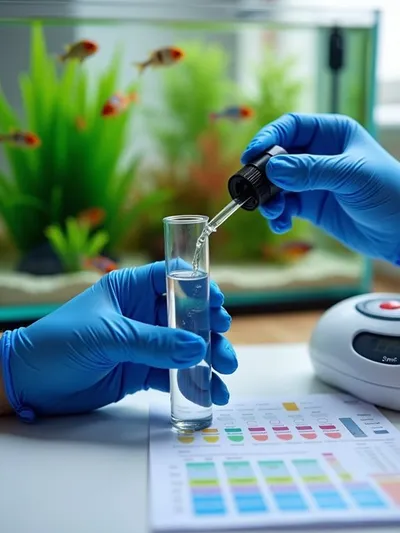
Even with careful monitoring, water hardness issues can still emerge in your aquarium.
One of the common misconceptions is that all tropical fish need the same water hardness level, which isn’t true! Different species have evolved in vastly different environments.
Watch for these hardness indicators: white deposits on glass, fish gasping at the surface, or scales appearing rough.
If your water’s too hard, try mixing in some distilled water or using peat moss in your filter.
For water that’s too soft, you can add crushed coral or limestone to gradually increase hardness. Maintaining the correct general hardness (GH) level is crucial for ensuring both fish compatibility and overall balance in your aquarium.
Establishing a Water Hardness Testing Schedule
Since maintaining proper water hardness is essential for your tropical fish’s health, you’ll need a consistent testing routine to avoid unexpected problems.
Consider your tank’s specific needs when establishing your testing frequency. Most aquarists should test weekly when first setting up a tank, then shift to bi-weekly or monthly checks once parameters stabilize.
Don’t forget to make seasonal adjustments to your testing schedule! Water conditions can change with the seasons, especially if your home’s temperature fluctuates.
- Test more frequently after adding new fish or plants
- Increase testing frequency during breeding periods when water quality is critical
- Schedule additional tests following water changes larger than 25%
- Test immediately if fish show signs of stress (erratic swimming, loss of color)
Frequently Asked Questions
Can Water Conditioners Affect Hardness Test Readings?
Yes, water conditioners can interfere with your hardness test readings. They often contain chemicals that alter testing accuracy, so you’ll want to test your water before adding conditioners for the most reliable results.
Does Water Hardness Influence Medication Effectiveness in Fish Tanks?
Yes, water hardness affects medication effectiveness. Hard water can reduce medication absorption in your fish’s system. You’ll notice some medications work better in soft water, while hard water might improve disease resistance in certain species.
How Does Hardness Relate to Ph Stability?
Higher water hardness improves pH buffering capacity, making your aquarium’s pH more stable. When you’re taking hardness measurements, remember that harder water resists pH changes, while softer water allows pH to fluctuate more dramatically.
Can Filtration Systems Alter Water Hardness Over Time?
Yes, your filtration system can alter water hardness over time. Without proper filter maintenance, media can release minerals or strip them from water, gradually shifting your water chemistry. Regular checks are essential.
Do Live Plants Affect Water Hardness Levels?
Yes, live plants affect water hardness by absorbing minerals. You’ll notice plant absorption gradually reduces hardness as they take up calcium and magnesium through mineral uptake, especially in heavily planted tanks with fast-growing species.
Final Thoughts
You’re now equipped to be your aquarium’s water hardness expert! By testing regularly and making adjustments when needed, you’ll provide your tropical fish with their ideal living conditions. Remember, maintaining proper water hardness isn’t just about healthy fish—it’s about creating a thriving underwater world. Keep your test kit handy, watch your finned friends closely, and enjoy the rewarding hobby of tropical fish keeping!

